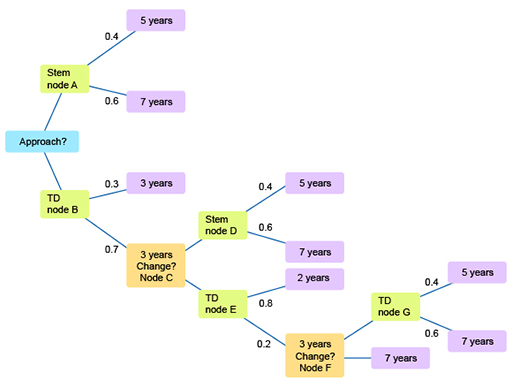4.3 A complex decision tree – developing a new pharmaceutical drug
Now that you have watched Video 5 that presents a more complex example of using decision trees, the next activity will give you an opportunity to practise the skill of building and evaluating a decision tree.
Activity 7 Example of a complex decision tree: considering the development of a new pharmaceutical drug
A pharmaceutical company is considering developing a new drug. The key decision criteria is the development time, which the company would like to minimise. There are two approaches to developing the drug. The first is to base it on stem cell research (‘stem’). There is a 0.4 probability that this approach would lead to a drug within 5 years, otherwise it will take up to 7 years (0.6 probability). Note, these times are from the start of the use of this approach.
An alternative approach is based on a method called targeted delivery (‘TD’). This has a 0.3 probability of delivering a drug within 3 years. However, if at the end of 3 years there is no drug, the company would have to choose between switching to stem or carrying on with TD. At that point, the TD will have a 0.8 probability of delivering the drug within a further 2 years.
Although, if the drug has still not been delivered after a further 2 years, the company can still switch to the stem approach. Alternatively, persevering at this stage with TD will definitely yield a drug after a further 7 years.
Given the objective is to minimise development time, use a decision tree to determine what the company’s strategy should be.
You can use pen and paper, an Excel spreadsheet, or record your calculations in the text box below.
Discussion
First, you should draw the decision tree. Your decision tree should look something like Figure 8 below.
As before, you start from the right-hand side and work back towards the start.
At node G, the expected development time from that point is (0.4 × 5) + (0.6 × 7) = 6.2 years. Note that this is the development time for stem, so you can use this calculation again.
As this is shorter than the alternative (7 years), at decision node F you would choose to start the stem approach, taking 6.2 years from that point. However, you have already waited 2 years before making that choice. From node E, there are 8.2 years (6.2 + 2) if you follow the lower branch (leading to node F).
So from node E you have an expected development time of (0.8 × 2) + (0.2 × 8.2) = 3.24 years.
You know that node D has an expected development time of 6.2 years (the stem time). At node C you would choose to carry on with TD as the expected time is lower (3.24 years). However, it has taken you 3 years to arrive at node C, so the development time is 6.24 years.
At node B, then, the expected development time is (0.3 × 3) + (0.7 × 6.24) = 5.27 years.
Now you have the strategy. As the first decision stem has an expected development time of 6.2 years, whereas the first decision TD has an expected development time of 5.27 years.
Thus, you would start on TD. If after three years you had not developed the drug (now at node C), you would choose to carry on with TD as the expected time at that point of 3.24 years is less than stem (6.2 years).
If after a further two years you still had not developed the drug (at node F), you would switch and start the stem approach, as 6.2 expected years for the stem approach is less than the definite 7 years it would take to complete the TD approach.

